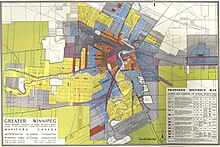This article has multiple issues. Please help improve it or discuss these issues on the talk page. (Learn how and when to remove these template messages)
|

Single-family zoning is a type of planning restriction applied to certain residential zones in the United States and Canada in order to restrict development to only allow single-family detached homes. It disallows townhomes, duplexes, and multifamily housing (apartments) from being built on any plot of land with this zoning designation.[1][2]
It is a form of exclusionary zoning,[3][4][5][6] and emerged as a way to keep minorities out of white neighborhoods.[1][3][5] Single-family zoning both increases the cost of housing units and decreases the supply.[7] In many United States cities, 75% of land zoned for residential uses is zoned single-family.[2]
Beginning in the late 2010's and early 2020's many cities across the United States have started looking at reforming their land-use regulations, particularly single-family zoning, in attempts to solve their housing shortages and reduce the racial inequities which arise from housing segregation.[8][9] These upzoning efforts would not require that new housing types be built in a neighborhood, it merely allows for flexibility in options. For example, changing a single family zoning district to a multifamily residential zoning district would not mandate single family detached homes be converted, nor would it prohibit new single family homes, it would just allow owners of those single family detached homes to subdivide their property, or owners of empty lots to build something other than a single family home.[8]
In the late 2010s and early 2020s, multiple states including California and Oregon as well as cities like Minneapolis and Charlottesville, Virginia have signed bills, made proposals, or started investigations to effectively eliminate single-family zoning. This includes requiring cities to approve two units and under certain conditions up to four units on single-family lots for example.[10][11][12]
- ^ a b Cite error: The named reference
KQEDwas invoked but never defined (see the help page). - ^ a b Badger, Emily; Bui, Quoctrung (June 18, 2019). "Cities Start to Question an American Ideal: A House With a Yard on Every Lot - Townhomes, duplexes and apartments are effectively banned in many neighborhoods. Now some communities regret it". The New York Times. ISSN 0362-4331. Archived from the original on August 3, 2020. Retrieved April 10, 2021.
Today the effect of single-family zoning is far-reaching: It is illegal on 75 percent of the residential land in many American cities to build anything other than a detached single-family home.
- ^ a b Cite error: The named reference
SJMN_2021-03-01was invoked but never defined (see the help page). - ^ Cite error: The named reference
SJMN_2021-02-24was invoked but never defined (see the help page). - ^ a b Cite error: The named reference
BS_1was invoked but never defined (see the help page). - ^ Cite error: The named reference
VOX 2021-02-17was invoked but never defined (see the help page). - ^ Cite error: The named reference
Brookings_2020was invoked but never defined (see the help page). - ^ a b Cite error: The named reference
NPR_2021-03-13was invoked but never defined (see the help page). - ^ Cite error: The named reference
WaPo_Minneapoliswas invoked but never defined (see the help page). - ^ Cite error: The named reference
sb-9-la-timeswas invoked but never defined (see the help page). - ^ Cite error: The named reference
dougherty-tweetwas invoked but never defined (see the help page). - ^ Cite error: The named reference
sb-9-nytwas invoked but never defined (see the help page).
© MMXXIII Rich X Search. We shall prevail. All rights reserved. Rich X Search
